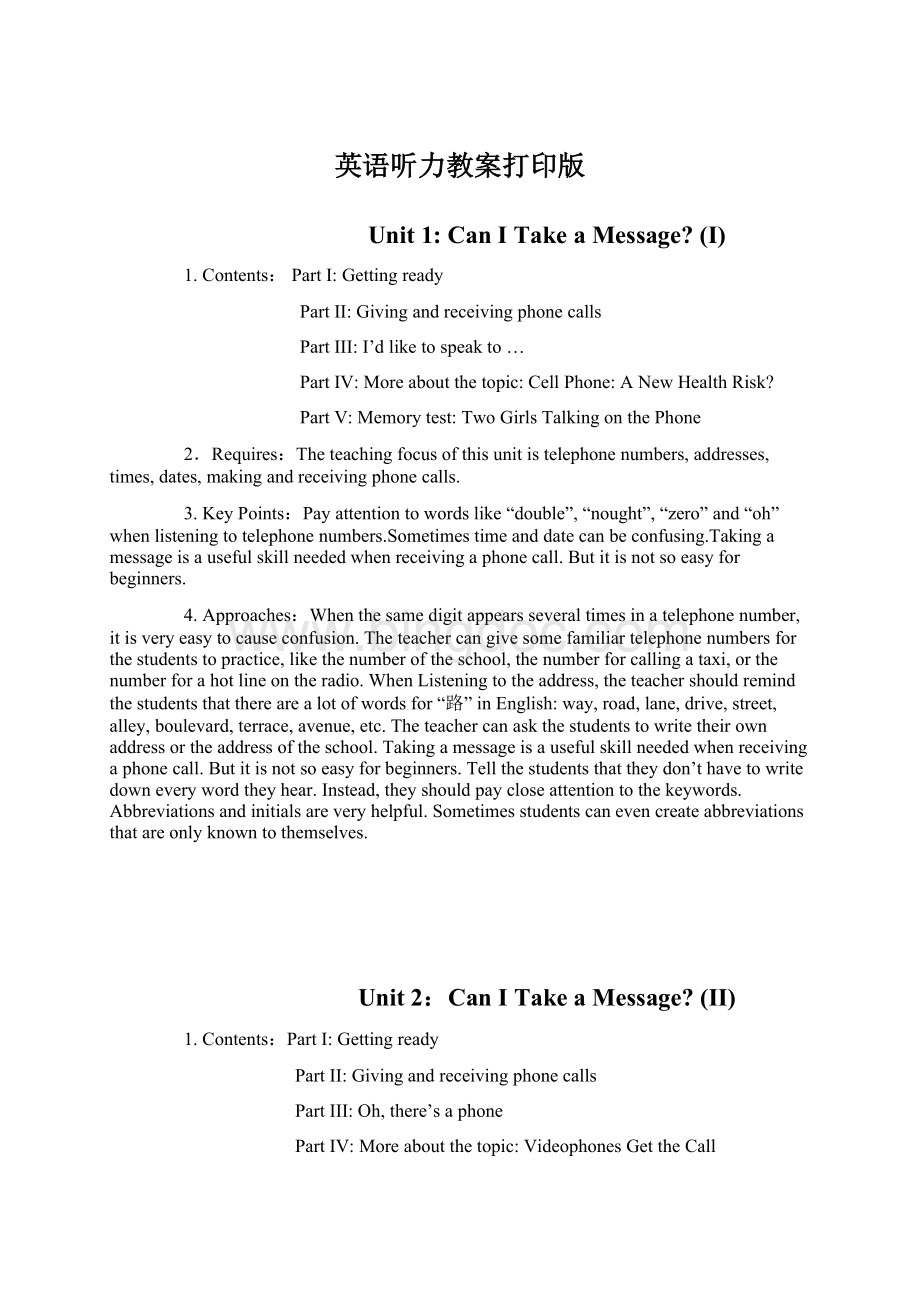英语听力教案打印版.docx
《英语听力教案打印版.docx》由会员分享,可在线阅读,更多相关《英语听力教案打印版.docx(10页珍藏版)》请在冰点文库上搜索。

英语听力教案打印版
Unit1:
CanITakeaMessage?
(I)
1.Contents:
PartI:
Gettingready
PartII:
Givingandreceivingphonecalls
PartIII:
I’dliketospeakto…
PartIV:
Moreaboutthetopic:
CellPhone:
ANewHealthRisk?
PartV:
Memorytest:
TwoGirlsTalkingonthePhone
2.Requires:
Theteachingfocusofthisunitistelephonenumbers,addresses,times,dates,makingandreceivingphonecalls.
3.KeyPoints:
Payattentiontowordslike“double”,“nought”,“zero”and“oh”whenlisteningtotelephonenumbers.Sometimestimeanddatecanbeconfusing.Takingamessageisausefulskillneededwhenreceivingaphonecall.Butitisnotsoeasyforbeginners.
4.Approaches:
Whenthesamedigitappearsseveraltimesinatelephonenumber,itisveryeasytocauseconfusion.Theteachercangivesomefamiliartelephonenumbersforthestudentstopractice,likethenumberoftheschool,thenumberforcallingataxi,orthenumberforahotlineontheradio.WhenListeningtotheaddress,theteachershouldremindthestudentsthattherearealotofwordsfor“路”inEnglish:
way,road,lane,drive,street,alley,boulevard,terrace,avenue,etc.Theteachercanaskthestudentstowritetheirownaddressortheaddressoftheschool.Takingamessageisausefulskillneededwhenreceivingaphonecall.Butitisnotsoeasyforbeginners.Tellthestudentsthattheydon’thavetowritedowneverywordtheyhear.Instead,theyshouldpaycloseattentiontothekeywords.Abbreviationsandinitialsareveryhelpful.Sometimesstudentscanevencreateabbreviationsthatareonlyknowntothemselves.
Unit2:
CanITakeaMessage?
(II)
1.Contents:
PartI:
Gettingready
PartII:
Givingandreceivingphonecalls
PartIII:
Oh,there’saphone
PartIV:
Moreaboutthetopic:
VideophonesGettheCall
PartV:
Memorytest:
HowtoMakeanInternationalDirectDialling(IDD)Call?
2.Requires:
Theteachingfocusofthisunitistelephonenumbers,addresses,times,dates,makingandreceivingphonecalls.
3.KeyPoints:
Payattentiontowordslike“double”,“nought”,“zero”and“oh”whenlisteningtotelephonenumbers.Sometimestimeanddatecanbeconfusing.Takingamessageisausefulskillneededwhenreceivingaphonecall.Butitisnotsoeasyforbeginners.
4.Approaches:
Whenthesamedigitappearsseveraltimesinatelephonenumber,itisveryeasytocauseconfusion.Theteachercangivesomefamiliartelephonenumbersforthestudentstopractice,likethenumberoftheschool,thenumberforcallingataxi,orthenumberforahotlineontheradio.WhenListeningtotheaddress,theteachershouldremindthestudentsthattherearealotofwordsfor“路”inEnglish:
way,road,lane,drive,street,alley,boulevard,terrace,avenue,etc.Theteachercanaskthestudentstowritetheirownaddressortheaddressoftheschool.Takingamessageisausefulskillneededwhenreceivingaphonecall.Butitisnotsoeasyforbeginners.Tellthestudentsthattheydon’thavetowritedowneverywordtheyhear.Instead,theyshouldpaycloseattentiontothekeywords.Abbreviationsandinitialsareveryhelpful.Sometimesstudentscanevencreateabbreviationsthatareonlyknowntothemselves.
Unit3:
ClearorCloudy?
1.Contents:
PartI:
Gettingready
PartII:
Aweatherreport
PartIII:
Atabusstop
PartIV:
Moreaboutthetopic:
IsEarthOverheating
PartV:
Memorytest:
WeatherForecast
2.Requires:
Thetrainingfocusofthisunitisweatherconditions,temperatures,times,percentages,andyears.
3.KeyPoints:
Asforweatherconditions,thefollowingvocabularymaybeuseful:
a.temperature:
freezing,cold,chilly,cool,mild,warm,hot.
b.sky:
sunny,clear,cloudy,overcast
c.humidity:
dry,damp,humid,wet
d.rain:
drizzle,shower,downpour,storm
e.wind:
breeze,gale
4.Approaches:
BeforelisteningtoanEnglishweatherforecast,theteachershoulddrawthestudents’attentiontothefollowing
points:
a.EnglishspeakersoftenuseFahrenheitinsteadofCentigradetomeasuretemperature.Noticethatzeroanddecimal
numbersareregardedasplural,forexample,zerodegrees;0.5degrees.
b.InanEnglishweatherforecast,theweathermanalwaysusesomebroadandgeneraltermsratherthanexactwords
topredictweatherinthefuture.
c.Besidesweatherconditions,thetemperature,winddirection,windspeed,anEnglishweatherforecastalsogivesthe
relativehumidityandthebarometricpressure.
d.Inordertounderstandaweatherforecastthoroughly,thestudentsshouldalsohaveaveryclearsenseofdirections.
Theteachercandrawacompassroseontheblackboardandaskthestudentstotellthedirections.
Theteachershouldalsoremindthestudentsofthewordcollocation,forexample,whilewecanusetheword“light”tomodifyboth“rain”and“wind”,wecanonlysay“heavyrain”but“strongwind”.
Unit4:
CanTimeMoveBackward?
1.Contents:
PartI:
Gettingready
PartII:
Localtime
PartIII:
Ladiesandgentlemen
PartIV:
Moreaboutthetopic:
TimingDevices
PartV:
Memorytest:
RadioAnnouncement
2.Requires:
Thetrainingfocusofthisunitistime,dayoftheweek,takingmessages,andnotetaking.
3.KeyPoints:
Timeisacommontopicinourdailylife.Thetechniqueofdealingwithtimewillbetrainedthroughoutthewholebook.
4.Approaches:
Beforegoingonwiththisunit,itwouldbebetterfortheteachertoreviewthefourdifferentwaysoftellingthetimewiththewholeclassasakindofwarm-upexercise.Theteachercandrawsomeclocksontheblackboard,andaskthestudentstotellthetimeshownontheclocksusingdifferentways.
Unit5:
FlyingInandOut
1.Contents:
PartI:
Gettingready
PartII:
Airportannouncements
PartIII:
AtriptotheStates
PartIV:
Moreaboutthetopic:
InflightTelephoneSystem
PartV:
Memorytest:
AirlineInformation
2.Requires:
Thetrainingfocusofthisunitisnumbers,times,dates,andprices.
3.KeyPoints:
Themostimportantactivityislisteningtoairlineinformation.Listeningtoairlineinformationonthetelephoneisquitedifferent.Mostprobably,youwillonlybegivenonechancetolistentoit.Ifyoumisstheinformationforthefirsttime,you’llhavetodialagain,thuscostingyoumore.Anotherthingthestudentsmayfinddifficultisthatthetelephoneairlineinformationisoftengivenwithaveryquickspeed.Solisteningtotelephoneairlineinformationcanbeachallengetomanystudents.
4.Approaches:
Thenumberheremainlyreferstotheflightnumber.It’salittlebitdifferentfromthetelephonenumber.Itdoesnothaveasmanydigitsasatelephonenumber.Andusuallytheabbreviationoftheairlineisusedinfrontofthenumber.Atypicalairlineannouncementusuallycontainsthefollowingaspects:
nameoftheairlines,fightnumber,destination,boardinggate,boardingtime,whetheritisdelayedornot,andifso,howlongwillthepassengershavetowait.Andtheannouncementswillbebroadcastinseveraldifferentlanguagesseveraltimestomakesurethatallthepassengerscangetthenecessaryinformation.Whileteaching
PartIIofthisunit,theteachercanplaythetapeseveraltimestomakesurethateverystudenthasgottherightinformation.
Unit6:
ByBusorbyTrain?
1.Contents:
PartI:
Gettingready
PartII:
Attherailwaystation
PartIII:
Whyarewewaitinghere?
PartIV:
Moreaboutthetopic:
AutomobilesintheUSA
PartV:
Memorytest:
BusInformation
2.Requires:
Thetrainingfocusofthisunitisnumbers,times.Pricesandcommonverbsusedwhentakingabus,taxioratrain.
3.KeyPoints:
Themostimportantactivityislisteningtobus/traininformation.
4.Approaches:
Thenumbersinthisbookaremainlyofthreekinds:
wholenumbers,fractionalnumbersanddecimalnumbers.Theteachershouldremindthestudentsofthedifferentwaysofreadingfractionalnumbersanddecimalnumbers.Arailwayannouncementisalmostlikeanairportannouncement.Itusuallycontainsdestination,platformnumber,departingtime,stopovers,whetheritisdelayedornot,andifso,howlongwillthepassengershavetowait.Theannouncementisusuallybroadcasttimes.Liketelephoneairlineinformation,busandsubwayinformationisalsoavailableonthetelephone.Theinformationisgivenwithaveryquickspeed.Theteachershouldencouragethestudentstochallengethemselves.
Unit7:
ThisWayorThatWay?
1.Contents:
PartI:
Gettingready
PartII:
Givingdirections
PartIII:
Findingtheway
PartIV:
Moreaboutthetopic:
Youcan’tMissIt
PartV:
Memorytest:
Steve’sFirstMorning
2.Requires:
Thetrainingfocusofthisunitistheunderstandingofspatialrelationsanddirectionalinstructions.
3.KeyPoints:
Twowordsareveryimportantandarefrequentlymentionedinthisunit.Theyare“right”and“left”.Peopleuse
thesetwowordstogivedirections.Toavoidambiguity,wordslikeeast,west,north,andsoutharesometimesusedinsteadof
“right”and“left”.
4.Approaches:
Instructionsinthisunitrefertoinstructionsshowingtheway.Thereforetheteachershouldtellthestudentsthatthe
understandingoftheseinstructionsmustbeaccurate,otherwisetheywillneverbeabletogettotherightplace.Thelistenersshould
beencouragedtorepeatthekeywordsoftheinstructionsandtotakedownsomenotes.
Unit8:
CashorCheque?
1.Contents:
PartI:
Gettingready
PartI